Energy conservation, renewable energy sources and energy management and efficiency overall are far from a matter of green buildings and, along with it, building energy performance certifications. A look at how energy efficiency and energy performance are changing the overall building landscape in 2018 and beyond.
Energy efficiency and energy conservation are top priorities for facility management and other management executives. With buildings accounting for close to 40 percent of all primary energy across the world and a strong predicted growth of electricity consumption, smart buildings and building management are poised to be further driven by the increasing focus on energy efficiency, as enabled by ever more data, analytics, intelligence and predictive capacities which in turn are fed by the growing leverage of smart sensors, the Internet of Things (IoT) and smart technologies in buildings.
The importance of energy efficiency and energy conservation (and the impact of IoT) among others show in BMS systems where there is an increasing integration with building energy management systems and systems that inevitably have an energy-related dimension such as lighting systems.
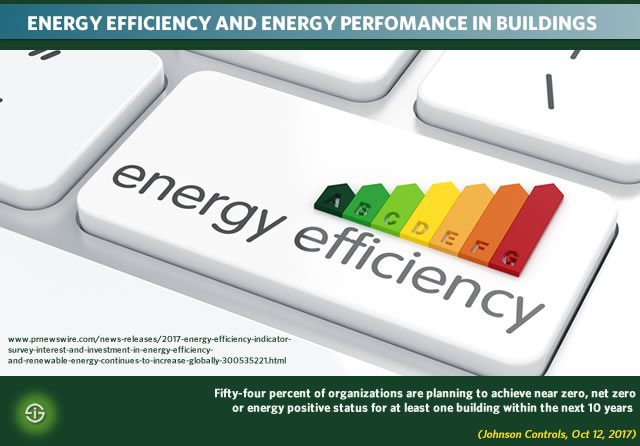
Energy efficiency in buildings and energy performance: a global priority with multiple drivers
This is not just the case in specific regions such as Europe where energy efficient building technology spending is expected to grow from $83.5 billion in 2017 to $111.9 billion in 2026 and regulatory frameworks such as the revised Energy Performance of Buildings or EBPD and Energy Efficiency Directive (EED) are among the drivers.
Energy efficiency and energy conservation have become a top priority across the globe, whether it concerns power management in critical power buildings, energy efficiency in small and medium buildings, energy management in larger residential and commercial buildings or energy conservation in the smart home. The global building energy management system market, although changing, is also growing across the globe for a reason.
We’ve tackled energy efficiency, and along with it energy performance and energy conservation, from many angles previously: cost savings, ecology and sustainability, energy management, Industry 4.0 and power management, regulations, green building certifications, you name it. Let’s take a look at the state, impact and future of energy efficiency and energy performance in buildings and facility management, as well as the various drivers for the increasing focus on energy efficiency across the globe.
As Martin Feder of EcoXpert says in our interview on evolutions in building management in the age of IP, IT and OT convergence and Industrial IoT, where we see the increasing role of IoT and intelligence moving to the edge in today’s integrated building management system (which increasingly serves as the digital hub where other building systems get connected and/or integrated with), energy efficiency and energy performance are key BMS market drivers.
The 2017 Johnson Controls Energy Efficiency Indicator survey: energy efficient building evolutions, plans, initiatives and drivers
That also shows in the results of the EEI 2017 survey (already the 11th edition). In October 2017, Johnson Controls announced the results of its EEI survey (in full, the Johnson Controls Energy Efficiency Indicator survey). Over 1,500 facility and management executives from the US, Canada and 10 other countries participated.
The survey gives an overview of how across these countries investments in energy efficiency and energy performance are evolving, as well as the key drivers for 2018 and beyond.
The results of the 2017 Johnson Controls Energy Efficiency Indicator survey show that 70 percent of organizations are paying more attention to energy efficiency than the year before and that 58 percent expect an increase of energy efficiency investments in 2018.
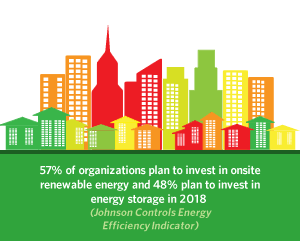 As said, enhancing energy efficiency obviously isn’t just related with ecology, sustainability, building energy performance in a scope of green buildings and greenhouse gas emissions reduction.
As said, enhancing energy efficiency obviously isn’t just related with ecology, sustainability, building energy performance in a scope of green buildings and greenhouse gas emissions reduction.
The top reason for the increased attention for energy efficiency and the planned increased investments across the globe is cost reduction. However, there are regional differences.
77 percent of all respondents cited cost reduction as a very or extremely significant factor in driving investments. In the US and Canada, however, greenhouse gas emissions reduction and increasing energy security were the main drivers with respectively 92 percent and 91 percent of respondents. Globally, the latter two drivers ranked second and third with customer attraction and retention ranking fourth (except in the US and Canada where attracting and retaining employees ranked fourth).
Energy efficiency obviously isn’t just a vast and multi-faceted given in the scope of buildings and facilities, it is also a contextual given, depending on among others the region and regulatory context.
In the previously mentioned research on the planned investments in energy efficient building technologies in Europe by Navigant Research we already saw that in the energy efficiency building drivers across the region: in Western Europe energy-related goals and emissions-related goals in the scope of sustainability legislation proved to be a dominant driver, along with increasing efficiency and the awareness regarding the need to reduce carbon emissions, while in Eastern Europe energy efficiency technology priorities were mainly revolving around the reliability and efficiency of the energy infrastructure, rather than energy efficiency and energy performance of buildings. However, here as well the call for strong mechanisms for building efficiency was growing.
The policies driving energy efficiency investments in buildings: more than about regulations and government policy
In other words: energy efficiency in buildings and facility management is a key priority everywhere, the differences are in the main drivers but everywhere across the globe greenhouse gas emissions reduction is and increasingly will be a key driver.
Of course in this scope government policy, regulations, incentives to retrofit buildings or as we see in some countries ‘punishments’ in the shape of taxes in case of not meeting forecasted energy consumption go hand in hand with the agendas of sustainability and greenhouse gas reduction but not just with that.
Moreover, there are ample building performance benchmarks and certifications which again overlap with the need to meet regulatory requirements regarding energy conservation, renewable energy and/or energy efficiency, but at the same time also overlap with other drivers and priorities from both the building owner and tenant/occupant perspective.
To put it otherwise: the drivers to invest more in energy efficiency in buildings and facility management can’t be nicely isolated from each other so one needs to be careful when interpreting and understanding the energy efficient building evolutions. By way of an example: certifications regarding building energy performance such as LEED fit in a green building perspective and help meeting regulations and policies but of course they also add to the value of the building and respond to changing demands of tenants who in the end often pay the bills.
As you can read in the press release regarding the 2017 Johnson Controls Energy Efficiency Indicator (EEI) survey government policy remains important with 52 percent of responding organizations citing it as a very or extremely driver for investment in energy efficiency in buildings.
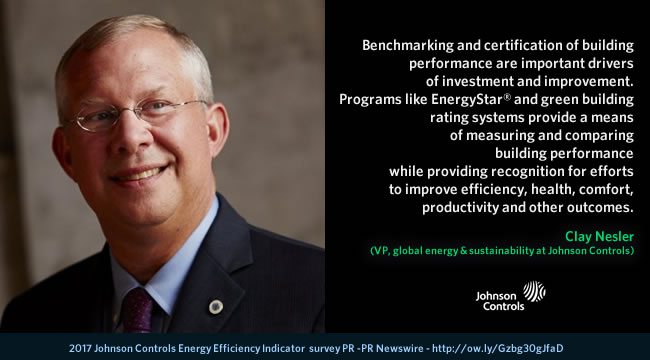
However, in the broader picture of policies that drive investments it’s not government policy alone that matters. Moreover, for the respondents government policy isn’t seen as the most effective of all policies that (could) lead to higher investments regarding energy efficiency of buildings.
On the first spot in the list of all these policies ranks building performance benchmarking and certification with a whopping 83 percent of respondents finding is very of extremely important. It is closely followed by government leadership in leasing, building design and retrofits, good for 81 percent of the participants at the Johnson Controls survey.
More takeaways and energy efficiency plans and measures: from HVAC to renewable energy and electric storage
When asked to identify the most effective policies driving investments in energy improvement, 83 percent of survey participants ranked building performance benchmarking and certification as very or extremely important, followed closely (81 percent) by government leadership in leasing, building design and retrofits.
Quoting Clay Nesler, VP global energy and sustainability at Johnson Controls who was recognized as a leader in the green building movement by the USGBC in 2017 (the US Green Building Council which launched the LEED green building certification): “Benchmarking and certification of building performance are important drivers of investment and improvement. Programs like EnergyStar and green building rating systems provide a means of measuring and comparing building performance while providing recognition for efforts to improve efficiency, health, comfort, productivity and other outcomes.”
And they do also respond to demands of tenants and owners who are also influenced by peer pressure, among others.
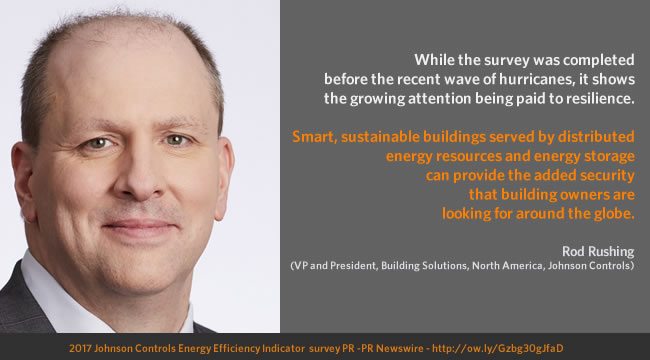
You can read more about the results of the 2017 Johnson Controls Energy Efficiency Indicator survey in the PDF document with more data from the 2017 EEI survey here.
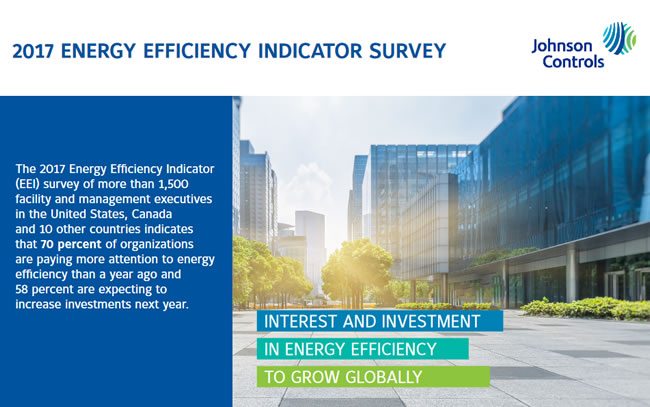
Top image: Shutterstock – Copyright: dencg – SCADA quote image: Shutterstock – Copyright: Drpixel – All other images are the property of their respective mentioned owners.

